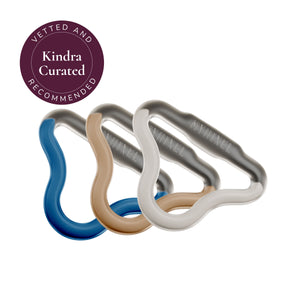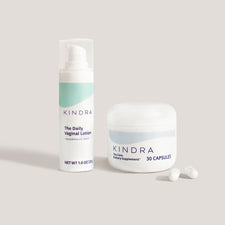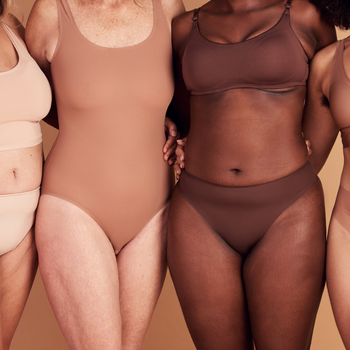When you think about getting older, you might automatically think of things like wrinkles, joint pain, and grandkids. But there’s one aspect of aging that is less discussed, but no less commonplace for millions of women: urinary incontinence.
Experts estimate that 30 to 40 percent of women between ages 40 and 60 experience urinary incontinence, aka losing control of your bladder; about half of all women over the age of 60 deal with it, too. In other words: It’s completely normal. (Just when you thought you’d be done with pads and panty liners for good, right?)
That said, just because menopause incontinence is common, doesn’t mean that you have to live with it for good. Here’s everything you need to know about putting it on hold for good.
What is Incontinence and Why Does It Happen During Menopause?
“Incontinence is the involuntary loss of urine or stool,” says Polly Watson, MD, FACOG, an OB/GYN who specializes in menopause medicine. Urinary incontinence in particular can happen to anyone in any life stage, but it is most commonly experienced in women after childbirth or in and after menopause. It can also be a symptom of a urinary tract infection.
Dr. Watson says that there are a few different reasons why incontinence becomes more likely during and after menopause — but a lot of it has to come down with the declining levels of estrogen that occur during this transition. As your body starts to produce less estrogen, your vaginal walls get thinner and weaker. This makes it more difficult to control the bladder. “Without as much of a cushion of the vaginal walls, there’s more of an urgency of ‘I’ve got to go,’” Dr. Watson says.
The decreased levels of estrogen post-menopause also change the microbiome of your vagina and urinary tract. This increases your risk of urinary tract infections (UTIs) and in turn, can cause temporary incontinence.
Dr. Watson says that there are also factors not directly related to menopause that can lead to incontinence. “Many people in menopause have trouble sleeping, so they may be consuming more caffeine during the day, and caffeine is a bladder irritant,” she says. Certain medications can also increase a sense of urgency (aka that feeling of needing to “go”), specifically blood pressure medicine, sedatives, and anticholinergics.
While anyone can develop urinary incontinence, the North American Menopause Society (NAMS) says vaginal childbirth is one of the main risk factors. Vaginal delivery puts a lot of strain on your pelvic floor muscles and nerves, and may cause lingering damage or weakness that gets worse as you age. Other factors that make someone more likely to experience urinary incontinence include being overweight, having a chronic condition like diabetes or multiple sclerosis, or taking one of the aforementioned medications.
Some women may experience fecal incontinence, where you can’t control your bowel movements. Like urinary incontinence, this is thanks to the drop in estrogen, which weakens muscles involved in emptying the bowels.
Types of Incontinence During Menopause
Interestingly, there are three distinct types of urinary incontinence. Knowing what you’re dealing with can help you better address treatment, since they manifest in different ways.
Stress incontinence
If you’ve ever laughed so hard you’ve peed, or experienced some leakage during a workout, you’ve dealt with stress incontinence. It’s when physical movement or activity puts stress on your bladder, making you pee. It can happen from sneezing, bending over, laughing, heavy lifting, or even sex.
Urge incontinence
Have you ever felt like you had to go, ASAP—and didn’t always make it to the bathroom in time? That’s urge incontinence. Basically, your bladder muscles are squeezing at the wrong times, which makes you pee no matter how much urine is actually in your bladder. Experts currently aren’t sure why someone in menopause may experience urge incontinence versus stress incontinence, although researchers have found that if you experience one type of incontinence, you’re more likely to experience the other types.
Nocturia
Nocturia means that you have to wake up to pee multiple times during the night. (As if we didn’t have enough trouble sleeping already!) If you have sleep apnea, you are more likely to experience nocturia, although researchers are still trying to figure out why there’s a connection.
Treatments for Incontinence During Menopause
Dr. Watson says that if you have incontinence and it’s impacting your daily life, it’s certainly worth making an appointment with a health-care provider to address because it’s not something you have to live with. “Especially if it’s disrupting your sleep, it’s important to manage it,” she says. She recommends starting with an appointment with your primary care provider or OB/GYN. Depending on what type of incontinence you have, and what’s likely causing it, your doctor may refer you to a urologist or a pelvic floor physical therapist for more guided treatments. Below are several different treatments that are used for incontinence during menopause:
1. Cutting back on caffeine
Since caffeine is a bladder irritant, Dr. Watson says it can also be helpful to minimize caffeine as much as possible, which can help with all three forms of menopause incontinence. Other common bladder irritants include carbonated drinks (sorry, seltzer lovers!), fruit juices, and alcohol. All should be consumed in moderation if you’re dealing with bladder issues.
2. Using pads and panty liners
This can be helpful for stress incontinence and urgency incontinence, making leakage much less embarrassing. This doesn’t treat the issues, but helps with day-to-day management to ensure that leakage doesn’t affect your clothing.
3. Trying pelvic floor therapy
“Working with a pelvic floor specialist can also be helpful for some,” Dr. Watson says. A pelvic floor specialist works with you to help to strengthen the vaginal walls and pelvic muscles. You might use devices like pelvic floor trainers, or learn particular stretches or strengthening moves to help restore muscle function. This treatment method can be helpful for both stress and urgency incontinence. (For more intel, check out our tips to keep your pelvic floor healthy during menopause and beyond.)
4. Taking medication
There are medications that can help with urge incontinence. Dr. Watson says these should only be considered after a careful conversation with your medical provider as they can cause dizziness, which can be dangerous as you age and become more at-risk of falling.
5. Undergoing surgery
If you are experiencing bowel incontinence, it’s possible you may need surgery, but this is done after extensive testing to ensure it’s the best way forward. Similar with urinary incontinence, working with a pelvic floor specialist can help with bowel incontinence too.
Outlook for Incontinence After Menopause
Even though hormone levels even out after menopause, Dr. Watson says that incontinence typically doesn’t just go away on its own. Don’t be discouraged by this because, again, there are great treatment options available. Work with your doctor to come up with a solution and then you can get back to living your best life—with a lot fewer frantic trips to the bathroom!
Sources:
Cleveland Clinic. Nocturia. Accessed 4/26/22.
Cleveland Clinic. Urinary Incontinence. October 2020.
Center For Colon Health & Rectal Health. Fecal Incontinence. Undated.
Doyle-McClam, M. et al. American Journal of Lifestyle Medicine. Nocturia in Women With Obstructive Sleep Apnea. May-June 2021.
Goldstein I. et al., The Journal of Sex Medicine. Multidisciplinary Overview of Vaginal Atrophy and Associated Genitourinary Symptoms in Postmenopausal Women. December 2013.
Johns Hopkins Medicine. Urinary Incontinence In Women. Undated.
Jones, H. et al. Journal of Women’s Health. Bladder Symptoms in the Early Menopausal Transition. May 2016.
Jung, C. and Brubaker, L. Climateric. The Etiology and Management of Recurrent Urinary Tract Infections in Postmenopausal Women. June 2019.
Kolodynska G. et al., Prz Menopauzalny. Urinary incontinence in postmenopausal women—causes, symptoms, treatment. April 2019.
Lohsiriwat S. et al., Urology Annals. Effect of caffeine on bladder function in patients with overactive bladder symptoms. January - April 2011.
Mayo Clinic. Bladder control: Medications for Urinary Problems. July 2022.
Mayo Clinic. Fecal Incontinence. November 2022.
Mayo Clinic. Stress Incontinence. March 2022.
National Library of Medicine. MedlinePlus. Urge Incontinence. July 2021.
North American Menopause Society. Urinary Incontinence. Undated.
Panesar, K. U.S. Pharmacist. Drug-Induced Urinary Incontinence. August 2014.
Pauwaert K. et al., International Urogynecology Journal. Nocturia through the menopausal transition and beyond: a narrative review. January 2021.
Subak L. et al., The Journal of Urology. Obesity and Urinary Incontinence: Epidemiology and Clinical Research Update. December 2010.
UCLA Health. Childbirth and Incontinence: Things You Should Know. Undated.
UCSF Health. Pelvic Floor Physical Therapy. Undated.
University of Iowa Hospitals and Clinics. Bladder Irritants. March 2020.
Quin S. et al., Climacteric. The effect of hormones on urinary incontinence in postmenopausal women. April 2009.













